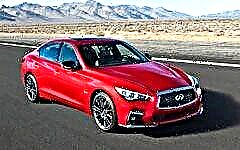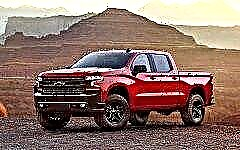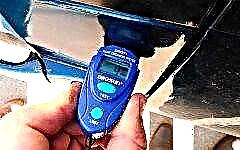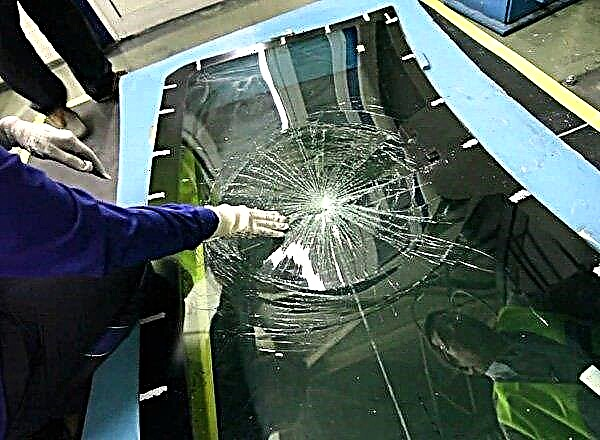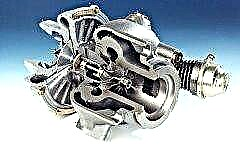

The content of the article:
- A bit of history and general theory
- Compression methods
- Working Principles of Automotive Air Turbocharger
- Advantages and disadvantages
- Features of work on gasoline engines
Since the development of the internal combustion engine, engineers have been faced with the task of increasing its power characteristics. Solving this problem by installing more cylinders entails a number of problems such as increasing the size and weight of the engine, therefore, it is not optimal.
Even at the dawn of the automotive industry, in 1905, a fundamentally different solution was proposed: increase engine power by injecting additional air into it... One of the options for this solution is a turbocharger.
A bit of history and general theory about the turbine

Pictured is a turbocharger
To understand the role of a turbocharger, it is enough to remember that cars equipped with an internal combustion engine could reach speeds of up to 200 km / h as early as 1909.
The number looks fantastic until the moment when another number comes up next to it: the volume of the engine that provided the car with this speed was… 28 liters! Naturally, there could be no question of any mass production of such monsters: they simply could not be serviced without special dimensional equipment.
And in order for the vehicle to become available to the wide masses of consumers, and not to turn into an analogue of a steam locomotive, the engine volume should have been reduced, while squeezing the maximum power out of it, if possible.
The idea of a supercharger of additional air flow allowed to increase the engine power by fifty percent. It is not difficult to understand the main points that determine the action of a technical unit if you know the principles of functioning of an automobile engine based on an internal combustion engine.
For the efficient operation of the combustion engine, the percentage of the air to fuel ratio in the combustion chamber is important. The natural limitation of the volume of the fuel-air mixture is the volume of the chamber, where this mixture enters due to the pressure drop at the fuel intake stroke and where it is ignited.
If you increase the amount of fuel mixture in the chamber, more power will be obtained during its combustion, which will increase the capabilities of the car. The supply of the mixture to the chamber under pressure (compression) allows this to be achieved.
- Read which is better: naturally aspirated or turbocharged engine
Compression methods

Throughout the history of the automotive industry, designers have created various air compression devices. Something remained on the pages of history, something went through the crucible of improvement and survived to this day. There are now four main ways to force air into the combustion chamber:
- mechanical pressurization - produced by the work of the crankshaft and is the progenitor of all other engineering solutions;
- turbocharger - an air mixture supercharger that operates due to the difference in pressure between the compressor and exhaust gases;
- electric turbocharging - a method of air injection with an electric compressor;
- combined supercharging - a device that combines the work of mechanical and turbo supercharging.
Working Principles of Automotive Air Turbocharger

In the photo, a diagram of the operation of the air turbocharger
There is a direct relationship between the volume of air in the engine cylinders and the volume of fuel burned in the internal combustion chamber. In this case, the more energy the exhaust gases have, the greater the torque received by the turbine wheels and, accordingly, the compressor itself.
A particular challenge in the design of a turbocharger is the selection of the material from which it is made. The turbine blades rotate at more than ten thousand revolutions per minute and can heat up to a thousand degrees. The cooling issue is partly solved by introducing additional airflow.
Typically, a turbocharger is equipped with a special vane ring, which is not only able to maintain a fixed pressure in the mass of exhaust gases, but also to regulate the state of this flow. In other words, turbochargers currently have the function of changing the internal geometry of the turbine.
Let's explain in more detail. When the engine speed is low and the flow of exhaust exhaust gases is low, the turbine, by reducing its internal cross section, increases the flow rate of exhaust gases going to the wheel. If the engine speed is high, the throughput of the turbine increases due to the increase in the cross section, and, consequently, the flow density of the exhaust gases passed through it decreases.
With this “smart” control, the range over which the turbo is effective is greatly expanded. Moreover, harmful emissions into the atmosphere are reduced, and fuel consumption is reduced.

- Read the specs of the BMW X7 with 4 turbos
Pros and cons of a turbocharger in a car

What are the advantages of turbochargers
Unlike early models of mechanical superchargers, which operated from the crankshaft and therefore used some of the engine's power, the operation of turbochargers uses essentially "gift" energy from the exhaust gases.
For this reason turbo superchargers are definitely a more efficient engineering solution.
In addition, the turbocharger is characterized by higher performance characteristics. From one liter of the engine, it can "squeeze" up to three hundred horsepower.
If the engine is equipped with a turbocharger, up to 40 percent is added to its power. At the same time, there is significant fuel savings.
If we talk about the efficiency, then the work of the turbo boost is "plus": with an increase in the size of the engine, its efficiency decreases due to friction losses and a decrease in thermal efficiency; therefore, the smaller the size of the engine (which is exactly what gives the presence of turbocharging), the higher its efficiency.
Disadvantages of turbochargers
There are also drawbacks to the given design, and the car owner should be aware of them.
- At low engine speeds, the turbo is not very efficient. This is natural - the low pressure of the exhaust gases is not able to "drive" the required volume of air into the chamber.
This problem is partly successfully solved due to the function of changing the geometry of the turbine depending on the intensity of the engine and the density of the exhaust gas flow.
- Another significant "minus" is the so-called "Turbo lag effect", when the driver is stepping on the gas, but at the first moment the car does not seem to react to it. Read in detail what a turbo lag is and why it occurs.
The effect is caused by the fact that without a rigid mechanical connection between the motor and the compressor, a discrepancy inevitably arises between the effect of the compressor operation and the required power, which is set by the driver when the accelerator pedal is pressed. Turbine inertia causes engine speed to "dip".
Experts combat this undesirable effect by tuning the engine using additional electric charging or installing a second turbocharger.
- After turning off the turbine, it should not stop immediately.The high speed of the impeller speed requires that after stopping the car the turbine has worked for some time at "idle" speed and cooled down. Otherwise, the device becomes unusable very quickly.
In order to avoid this, the turbocharger is equipped with a turbo timer, which is programmed to run the turbine idle for a certain time after the vehicle stops.
If the car is “finished” by a handicraft method and is equipped with a turbine without a turbo timer, the motorist will have to take care of its correct cooling and stopping after the engine is stopped.
- Finally, turbochargers are not the cheapest technical unit in a car, since it requires great accuracy of work and has such a function as changing the geometry of the turbine depending on the flow density of the exhaust gases.
Features of work on gasoline engines

The turbocharger for gasoline engines is effective on injection engines. If there is a desire to install this unit on a carburetor motor, this will require a number of modifications - from adjusting the level of the float chamber to replacing the nozzles with a larger section.
If the device is installed on an injection engine, the work will be limited to just a new firmware.
Turbochargers have proven their worth. It is not for nothing that most sports cars are equipped with them. This technical unit is used both at the stage of car production and in a situation when the car owner wants to perform car tuning. The high level of efficiency and a number of solutions found to eliminate the turbo lag effect make the use of a turbo supercharger the most effective at the level of other methods of increasing the pressure in the combustion chamber.
- Related article: How to repair a turbocharger




